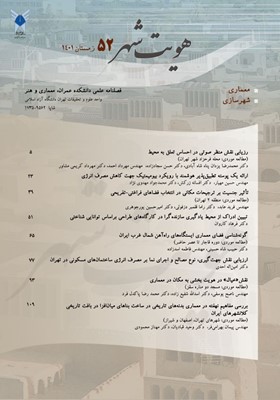ارزیابی نقش جهتگیری، نوع مصالح و اجرای نمابر مصرف انرژی ساختمانهای مسکونی در تهران
محورهای موضوعی : معماری
1 - استادیار، گروه معماری، واحد پرند، دانشگاه آزاد اسلامی، پرند، ایران.
کلید واژه: کاهش مصرف انرژی, جدارههای خارجی ساختمان, شهر تهران, ساختمانهای مسکونی,
چکیده مقاله :
غالب ساختمانهای امروزی به علت نداشتن طراحی اقلیمی، ناگزیر از مصرف بالای انرژی جهت تهویه، گرمایش، سرمایش، روشنایی و آسایش حرارتى هستند. این پژوهش به این سؤال پاسخ میدهد که در بین مصالح و جزییات اجرائی رایج نماسازی در شهر تهران، حالت بهینه در کاهش مصرف انرژی ساختمانهای مسکونی چیست و تأثیر جهتگیری نما در مصرف انرژی ساختمانهای مسکونی چقدر است. به این منظور، شبیهسازی با نرمافزار Energy plus v8.6 جهت تحلیل حرارتی و مصرف انرژی ساختمان انجامشده است. نتایج پژوهش نشان میدهد که در میان 13 نوع نمای رایج، بهترین مصالح نما در میان مصالح متداول، آجر و پانل بتنی و بهترین نحوه اجرا، اجرای خشک این مصالح میباشد. واحدهای جنوبی کمترین مجموع بار سرمایشی و گرمایشی مصرفی رادارند و بعدازآن به ترتیب واحدهای شرقی (16% بیشتر از واحدهای جنوبی)، غربی (15 تا 17% بیشتر واحدهای جنوبی) و شمالی (18 تا 20% بیشتر از واحدهای جنوبی) قرار دارند.
In this research, focusing on the East, West and South regions of Tehran, the cooling and heating load in residential buildings in different geographical directions has been compared, and concerning the building façade material and construction details, optimal choices have been proposed. This study answers these questions, which of the typical façade materials and construction detail in Tehran city have the best performance in reducing the energy consumption of residential buildings, and what is the effect of facade direction on heating and cooling energy consumption of residential buildings. For this purpose, the simulation tool has been utilized using Energy plus software with a design-builder interface for thermal analysis. The results of this study show that the heating load of residential buildings in Tehran is higher than the cooling load in the western and northern units and the cooling load of the building is higher than the heating load in the southern and eastern units. In this regard, the heating load in the west facing units is 8%, and in the north units, it is 15 to 26% more than the cooling load. In south-facing units, the heating load of the building is 11 to 30%, and in east-facing units, the heating load of the building is up to 20% less than the cooling load. Comparison of heating load in southern, northern, eastern and western units shows that the best orientation of the building in Tehran to reduce the heating load of the building are respectively south-facing, east-facing (19 to 22% more than the southern unit), west-facing (20 to 25% more than southern units) and north-facing (30 to 40% more than southern units). The best orientation of the building in Tehran to reduce the cooling load of the building are the units facing south, north (0.5 to 7.5% more than the southern unit), west (6.5 to 7% more than the southern unit) and east (10.5 more than the southern unit) respectively. Regarding total cooling and heating load, the best orientation of the building in Tehran to reduce energy consumption are respectively south and then east facing units (about 16% more than southern units), west (15 to 17% more than southern units) and north (18 to 20% more in different views than southern units). The priorities of selection of facade materials and construction details in southern facades are brick facades with dry connection method, concrete panels with dry connection method and stone facades with dry connection method. In north-facing units, this arrangement includes a brick facade with a dry connection method, concrete panels with a dry connection method and stone facades with a dry connection method. In the west facing units, concrete panels with dry connection method, brick facades with dry connection method, and stone facades with dry connection method are the best. In the east facing units, brick facades with dry connection method, stone facades with dry connection method, ceramic facades with dry connection method and concrete panels with dry connection method have better performance in reducing the energy consumption of the building.
_||_

